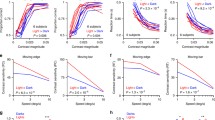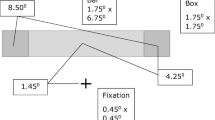Abstract
STATIONARY lines appear to move upwards after prolonged visual exposure to downward moving lines. The experiment reported here shows that the movement after-effect is appreciably diminished when the moving lines observed during inspection are seen in red light and the stationary test lines are viewed in green light. We expected to obtain colour selectivity in the movement after-effect following the demonstration of motion-specific colour after-effects by Hepler1. She found that alternate exposure to downward moving green lines and upward moving red lines caused downward moving lines later seen in white light to appear red and upward moving lines green. Hepler proposed that motion detectors in the human visual system are also selective to wavelength so that during exposure to one stimulus only the neural analysers tuned to both the specific direction of motion and the wavelength are excited. Because these analysers adapt during inspection and are suppressed for a period of time afterwards, the downward moving lines presented in white light as the test stimulus are signalled via downward-selective motion detectors tuned to the opposite colour. McCollough2 has offered a similar explanation of colour after-effects which are specific to contour orientation.
Similar content being viewed by others
References
Hepler, N., Science, 162, 376 (1968).
McCollough, C., Science, 149, 1115 (1965).
Day, R. H., and Strelow, E., Nature, 230, 55 (1971).
Scott, T. R., and Wood, D. Z., Amer. J. Psychol., 79, 435 (1966).
Stroymeyer, C. F., and Mansfield, R. J. W., Percept. Psychophys., 7, 108 (1970).
Barlow, H. B., and Hill, R. M., Nature, 200, 1434 (1963).
Author information
Authors and Affiliations
Rights and permissions
About this article
Cite this article
LOVEGROVE, W., OVER, R. & BROERSE, J. Colour Selectivity in Motion After-effect. Nature 238, 334–335 (1972). https://doi.org/10.1038/238334a0
Received:
Issue Date:
DOI: https://doi.org/10.1038/238334a0
- Springer Nature Limited
This article is cited by
-
A neural network model of the McCollough effect
Biological Cybernetics (1976)





